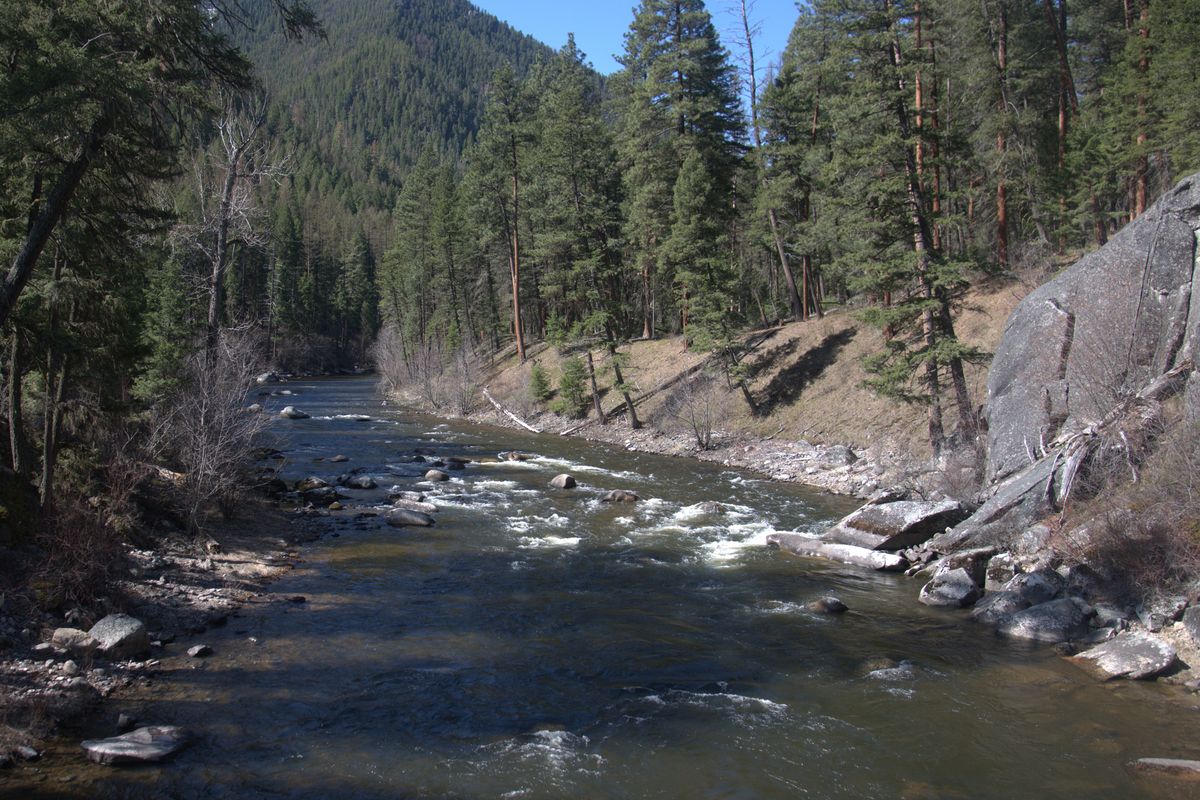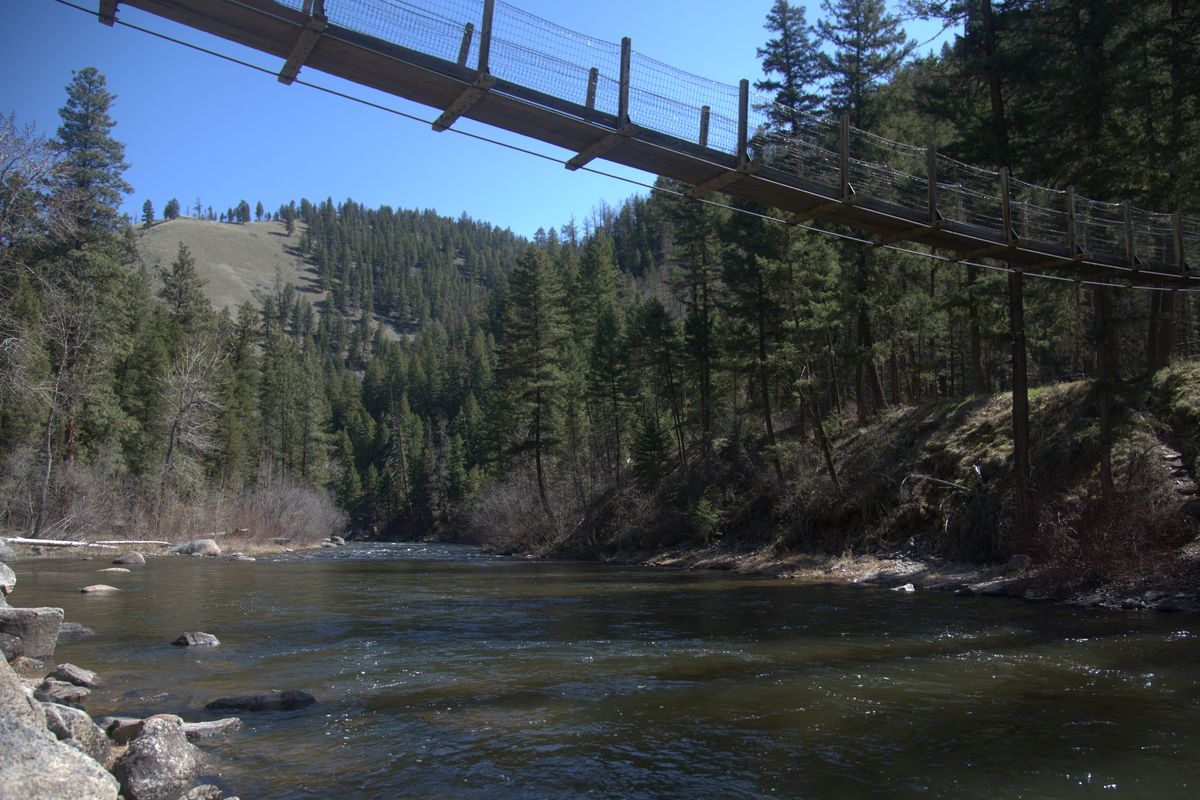Michael Wright: Searching for stoneflies on Montana’s Rock Creek
The Welcome Creek Trail begins at this swinging bridge over Rock Creek, near Clinton, Montana. (Michael Wright/The Spokesman-Review )
CLINTON, Mont. – The Rock Creek Fisherman’s Mercantile has anything an angler might want. Cold beer, fresh flies, tippett, leader, other miscellany that’s easy to leave at home. It’s the perfect store in the perfect spot – right off the interstate and at the opening of a canyon full of fish and possibility.
I didn’t need anything when I stopped there on a recent sunny morning, but it’s just one of those places I can’t drive past without stopping to spend a few bucks. An extra bottle of water or a candy bar never hurt anybody. Besides, there’s no better place to get the latest report on Rock Creek, which dumps into the Clark Fork River northwest of the store.
The water was clear and it was going to be sunny. The only thing I needed to decide was how far to drive. Rock Creek Road runs more than 30 miles up the canyon toward the town of Philipsburg, paralleling the creek most of the way. The guy at the counter suggested going all the way to a spot with a name I hadn’t heard before, despite spending four years in Missoula for college and returning to this lovely stream once or twice a year in the decade since. There’s always something new to learn.
His point was that I should drive as far as I can fathom, and that doing so would lead me to fish that had seen fewer flies this year.
This was the last week of April. I was out for something resembling redemption.
All winter long, I’d told myself I was going to fish the skwala hatch on the Yakima River in March or April. Skwalas are inch-long stoneflies that trout gulp down with big splashy eats. For anglers, they’re a reason to cast fluffy dry flies. I didn’t want to miss it. At the fly tying vise this winter, I spun up anatomically precise patterns with foam, rubber legs and deer hair. They were pretty.
Then March came and went without a trip west. So did the first two weeks of April. Online reports seemed to indicate that the Yakima’s peak skwala time was gone. Soon salmonflies would hatch there. I’d blown it.
Two states east, seasons move a little slower. On a stream like Rock Creek, in a deep canyon where the sun rises late and sets early, it has always seemed to me that the hatches run even later. It was also one of the places I’d first fished with skwalas, often in late April. A 10-year-old picture from Facebook confirmed: I once caught a fat cutthroat on a skwala on April 19.
My father and I were spending the final weekend of the month in Dillon to fish the Beaverhead and the Big Hole. I left Spokane a couple days early to give myself a full day on Rock Creek to hunt for stoneflies.
The prognosis wasn’t great. Fishing reports indicated the skwala hatch was waning, though there were still a few around. Neumoras, a smaller stonefly, would also be in the mix. The most consistent hatch was reportedly the spring assortment of mayflies, at least on cloudy days.
There were no clouds overhead or in the forecast, which is bad for mayflies but good for skwalas. Sunshine is good for getting them to hatch, even if it might make the fish wary of coming to the surface. The guy at the Merc said the sunshine could mean that it was going to be the first good skwala day in a while.
So I drove way up the canyon, past spots I used to know well. Creek has always seemed like the wrong surname for Rock Creek, which is wider and wilder than a lot of rivers. Wading across it is tough even at low flows. Rafts float the upper stretches at certain times in the early season, although doing so requires navigating a complex and ever-changing network of downed trees and other river hazards.
I pulled off the road at the swinging bridge at the Welcome Creek Trailhead, the somewhat rickety entrance to the Welcome Creek Wilderness Area. The sun wasn’t over the canyon walls yet, so it seemed like it was too early to bet on dry flies.
I dug out a bobber and dredged the holes beneath the bridge with stonefly patterns. No fish showed themselves there. When I moved downstream, one fish ate the nymph but spat the hook. It was a slow morning.
There were no obvious signs that skwalas were around. No nymphs underneath rocks, no petrified shucks. There were a few mayflies in the air but not much else.
By lunch, I was convinced it was going to be a day of unrealized potential. Skwalas seemed off the menu, and it didn’t seem like the other three or four hatches in play were going to turn up. Variety is good, but it’s no guarantee of good fishing. There was nothing better to do than fish, though, so I drove downstream and bounced between some of my favorite spots.
Around 4:30 p.m., I made my way through a patch of cottonwood trees to a spot on the creek’s main channel a few miles upstream from the store. The last stop of the day. My wife called when I reached the bank, providing the disappointing revelation that cell phones work on the lower reaches of the creek.
We talked for about a minute. Then there was a splash off to my left. I looked over and saw fish rising a few feet off the bank, behind a mess of gnarled wood. I told my wife I had to go.
There were a few neumoras in the air, those little brown stoneflies with two distinct wings. My fancy skwalas would be too big, in addition to being the wrong color.
I don’t remember the last time I tied neumoras. They aren’t hard to tie. Brown body, grizzly hackle, elk or deer hair, a little bit of black foam for an egg sac. They’re just an afterthought.
There was exactly one in a fly box I rarely open. It wasn’t as pretty as my skwalas, but it worked.


